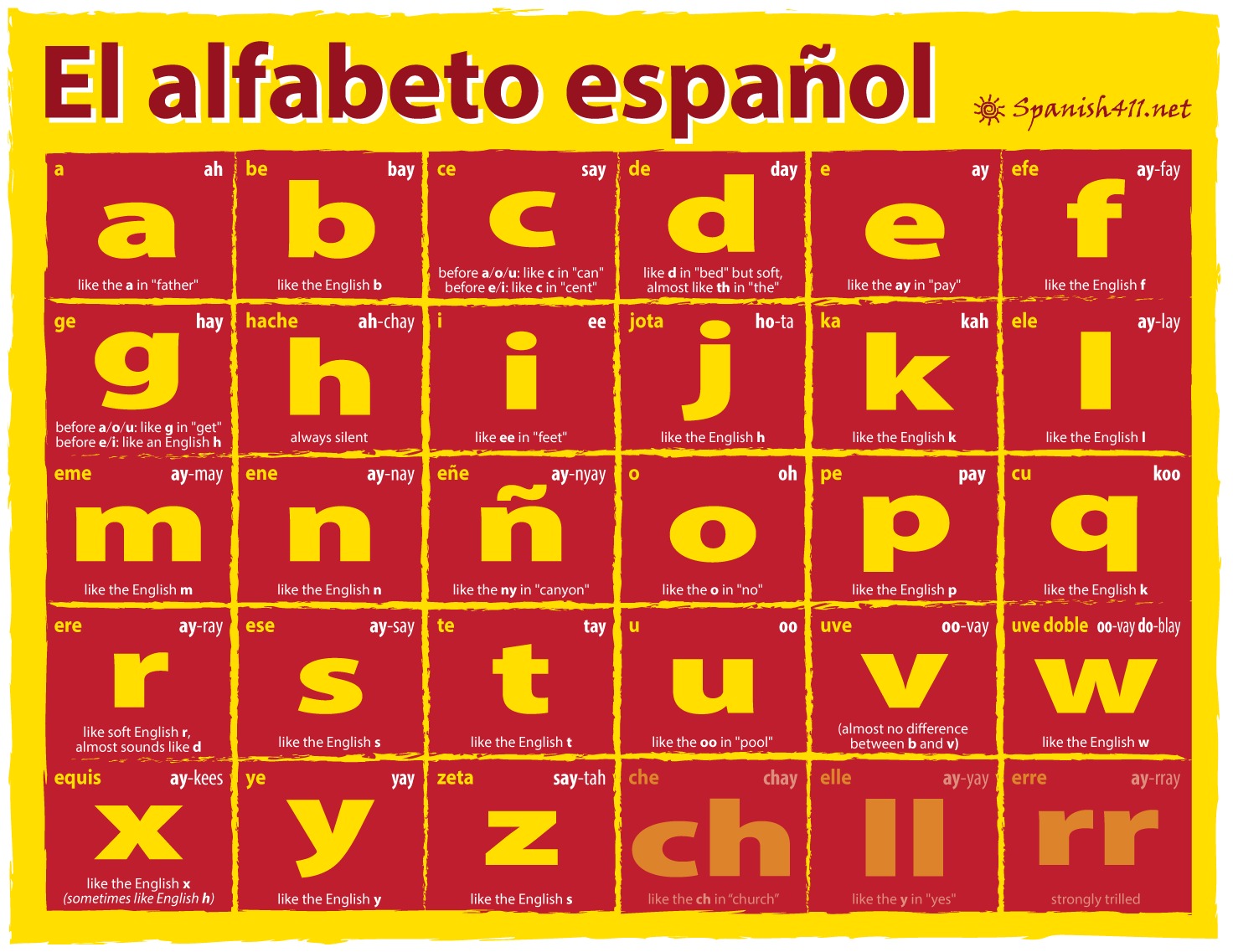Ask any second-grader how many letters there are in the alphabet and they’ll tell you there are 26 and maybe even sing you a song:
a,
b, c, d, e, f, g, h, i, j, k, l, m, n, o, p, q, r, s, t, u, v, w, x, y, z
(Now I know my ABCs, next time won’t you sing with me?)
Ask several Spanish-speakers how many letters there are in the alphabet and you’ll get several different answers (with or without a song). Not everyone in the Spanish-speaking world agrees on what the alphabet looks like. For many years this was the official Spanish alphabet:
a, b, c, ch,
d, e, f, g, h, i, j, k, l, ll, m, n, ñ,
o, p, q, r, s, t, u, v, w, x, y, z
So in older Spanish dictionaries words
beginning with “ch” are listed in a separate section after the rest
of the “c” words, and words beginning with “ll” are listed
after the rest of the “l” words. However, in 2010 the Real Academia Española,
which is basically in charge of the official Spanish language, decided that “ch” and “ll” should
no longer be considered distinct letters. This leaves us with a 27-letter alphabet:
a, b, c, d, e, f, g, h, i, j, k, l, m, n, ñ,
o, p, q, r, s, t, u, v, w, x, y, z
To confuse the issue, some Spanish-language sources consider “rr” a separate letter and others don’t
count the “k” or the “w” since they almost always appear in words that originated outside of the Spanish language.
Fun Fact: The letter “e” is the most common letter in both English and Spanish.
Fun Fact: The letter “w” is the least used letter in Spanish.
So how many letters
are there? Officially there are 27, but you may find answers anywhere between 25 (“ñ,” but
no “k” or “w”) and 30 (the 26 you’re used to plus “ch,”
“ll,” “ñ,” and “rr.”) Just to cover all the
bases let’s work with a 30-letter alphabet.
Below are a list of letters,
their names in Spanish, and a pronunciation guide:
|
Letter
|
Spanish
|
English
|
Pronunciation
|
|
 a a
|
a
|
ah
|
like the
a in “father”
|
|
 b b
|
be
|
bay
|
like
the English b but pronounced very softly
|
|
 c c
|
ce
|
say
|
before a, o, u, like the c
in “can”; before e, i, like the c in “cent”
|
|
 ch ch
|
che
|
chay
|
like the ch in “church”
|
|
 d d
|
de
|
day
|
like d in “bed”
but with tongue forward, almost like th in “the”
|
|
 e e
|
e
|
ay
|
like the ay in “pay”
|
|
 f f
|
efe
|
ay-fay
|
like the English f
|
|
 g g
|
ge
|
hay
|
before
a, o, u, like g in “get”; before e, i, like an English h
|
|
 h h
|
hache
|
ah-chay
|
always silent
|
|
 i i
|
i
|
ee
|
like ee in “feet”
|
|
 j j
|
jota
|
ho-ta
|
like the English h
|
|
 k k
|
ka
|
kah
|
like
the English k
|
|
 l l
|
ele
|
ay-lay
|
like the English l
|
|
 ll ll
|
elle
|
ay-yay
|
like the y in “yes”
|
|
 m m
|
eme
|
ay-may
|
like the English m
|
|
 n n
|
ene
|
ay-nay
|
like the English n
|
|
 ñ ñ
|
eñe
|
ay-nyay
|
like the ny in “canyon”
|
|
 o o
|
o
|
oh
|
like the o in “no”
|
|
 p p
|
pe
|
pay
|
like the English p
|
|
 q q
|
cu
|
koo
|
like the English k
|
|
 r r
|
ere
|
ay-ray
|
like the English r but softer, almost sounds like a d
|
|
 rr rr
|
erre
|
ay-rray
|
strongly trilled
|
|
 s s
|
ese
|
ay-say
|
like the English s
|
|
 t t
|
te
|
tay
|
like
the English t
|
|
 u u
|
u
|
oo
|
like
the oo in “pool”
|
|
 v v
|
uve
|
oo-vay
|
almost
no difference between b and v in Spanish
|
|
 w w
|
uve doble
|
oo-vay do-blay
|
like the English w
|
|
 x x
|
equis
|
ay-kees
|
like the English x
|
|
 y y
|
ye
|
yay
|
like the English y; like
ee in “tree” when used alone
|
|
 z z
|
zeta
|
say-ta
|
like the English s
|
Notes on Spanish Letters
- The letter “e” is also
pronounced at times more like the “e” in “pet,” especially
when at the beginning of a word, or when spoken quickly.
- When a “g”
precedes an “e” or an “i” in a word it is pronounced like
an “h” but with a slight rasping sound, almost like clearing one’s throat.
- The letter “h” may be pronouced as it is in English in loan words that didn’t originate in Spanish (e.g. “Hawaii”).
-
Due to the limited usefullness of the letter “h,” some (including
noted Colombian author Gabriel Garcia Márquez) have called for it to be
removed from the Spanish language entirely.
- The letter “i” was once called i latina to distiguish it from the letter “y,” known as i griega. (Latin and Greek i’s respectively.)
- Words beginning with “k,”
“w,” and “x” were adopted into Spanish from other languages
and are therefore very rare.
- The letter “ñ” is not a variation of “n,” but a distinct letter. The word pino will appear before the word piña in a dictionary because “n” comes before “ñ” in the alphabet.
- Words beginning with “r” are
usually trilled as if they began with “rr” (e.g. rojo = rrojo).
- The letter “v” is officially uve but it is also called ve. Because ve and be sound so similar, “b” is sometimes called be grande, be alta, or be larga and
“v” is called ve chica, ve pequeña, or ve corta. It’s
not uncommon in some Latin American countries to see signs with spelling errors
involving “b” and “v” such as Se Bende instead Se Vende.
- There
are at least four ways to say the letter “w” in Spanish: doble
ve, doble u, doble uve, or uve doble. The “w” is extremely rare in Spanish.
- There are many Spanish
words borrowed from indigenous languages where the “x” is pronounced
like the English “h” (e.g. México).
- The letter “y” is officially called ye as of 2010, but many people know it as i griega.
- The pronunciation
of the letter “z” (as well as “c” when followed by an “e”
or an “i”) varies widely.
- In regions of Spain, “c”
and “z” are pronounced more like “th” (e.g. Barcelona = Barthelona).
Other Notes
- Spanish letters
are all feminine: la a, la be, la ce, etc.
- You
may be wondering about letters with accents like á, é, í, ó, and ú or the rare
dieresis, ü. These are not considered separate letters.
- “Alphabet”
is el alfabeto in Spanish, but you can also say el abecedario which is a word made up of the first three letters of the alphabet (like saying
“ABCs”).
- Alfabetizar means “to alphabetize”
but it can also mean “to teach reading and writing.”


 This work by Spanish411.net is licensed under a Creative Commons Attribution-NonCommercial-ShareAlike 4.0 International License.
This work by Spanish411.net is licensed under a Creative Commons Attribution-NonCommercial-ShareAlike 4.0 International License.


